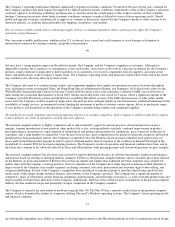Apple 2003 Annual Report Download - page 25
Download and view the complete annual report
Please find page 25 of the 2003 Apple annual report below. You can navigate through the pages in the report by either clicking on the pages listed below, or by using the keyword search tool below to find specific information within the annual report.
Apple-owned retail stores in the United States and opened its first international store in Tokyo, Japan in the first quarter of 2004. Each
reportable operating segment provides similar hardware and software products and similar services. Further information regarding the
Company's operating segments may be found in Item 8 of this Form 10-K in the Notes to Consolidated Financial Statements at Note 11,
"Segment Information and Geographic Data."
Americas
Net sales in the Americas segment during 2003 increased $50 million or 2% compared to 2002. During 2003 and 2002, the Americas segment
represented approximately 51% and 55%, respectively, of the Company's total net sales and represented approximately 54% and 56%,
respectively, of total Macintosh unit sales. The results of the Americas segment are similar to the overall results of the Company as they reflect
substantially lower unit sales and net sales of Power Macintosh systems and iMac systems, partially offset by increases in unit sales and net
sales of PowerBooks. The net sales of the Americas segment, and the Company in total, also reflect substantially higher sales of peripherals,
software, and services during 2003 compared to 2002 due primarily to higher sales of iPods and Internet services. The Americas segment has
been negatively affected by weakness in its U.S. education channel. As noted above, total net sales and unit sales in the U.S. education channel
during 2003 were down 4% and 6%, respectively, compared to the same period in 2002. The Company believes this decline is caused by
increased competition in the education market and by a reduction in spending by U.S. educational institutions due to federal and state funding
concerns and tax revenue shortfalls resulting from the weak economy. Additionally, some of the decline during 2003 in net sales and unit sales
of Macintosh systems in the Americas segment may be the result of the operation of the Company's Retail segment whose net sales, all of
which occurred within the U.S., increased significantly during 2003.
Net sales for the Americas segment increased 3% or $94 million in 2002 compared to 2001. The Americas segment was negatively affected by
a decline in U.S. education sales in 2002 of $215 million. The Americas segment also experienced a 17% decline in Power Macintosh unit
sales. However, outside of the U.S. education channel, unit sales of consumer desktop and portable systems rebounded from the substantial
declines experienced in 2001, rising a combined 31% in 2002. Sales of software, peripherals, and accessories were also up in the Americas
during 2002. Growth in unit sales of consumer oriented systems during 2002 in the Americas is somewhat attributable to the significantly
depressed level of net sales experienced in the first quarter of 2001 as discussed above. However, growth in the Americas was somewhat
negatively affected, particularly with respect to consumer-oriented systems, by the significant growth of the Company's Retail segment in the
U.S. More than 70% of the Retail segment's Macintosh unit sales during 2002 were for iMacs and iBooks.
Europe
Net sales in Europe increased $58 million or 5% during 2003 as compared to 2002 while Macintosh unit sales declined by 5% during the same
period. Europe's operating results were consistent with the trend experienced in the Americas and by the Company as a whole. Europe
experienced weakened demand for Power Macintosh, iMac and iBook systems in 2003, partially offset by strong demand for PowerBooks
whose net sales increased by 48% or $100 million from 2002. Europe also realized increased sales of peripherals, software, and service,
primarily attributable to higher sales of iPods, accessories and APP.
Economic conditions in Europe remained weak throughout 2002, and the overall demand for the Company's products in that region remained
flat during 2002 versus 2001. Unit sales in Europe for 2002 reflect relatively stronger demand for consumer-oriented products, particularly
iBook whose unit sales increased 27% in 2002, offset by declines in Power Macintosh unit sales.
Japan
Net sales in Japan decreased $12 million or 2% during 2003 as compared to the same period in 2002, the weakest year
-to-date performance of
any of the Company's operating segments. Japan's Macintosh unit
29
sales were particularly weak in 2003, declining 12%, and were primarily attributable to lower sales of iMac and iBook systems, partially offset
by an increase in PowerBook sales as well as higher sales of peripherals and other hardware. Japan's Macintosh unit sales remain significantly
below the segment's historic levels due to current economic conditions that remain particularly negative in Japan.
Net sales in Japan remained flat during 2002 versus 2001, with a slight decline in unit sales of 2%. Consistent with the Company's other
geographic operating segments, during 2002 Japan showed growth in unit sales of consumer systems and a decline in unit sales of Power
Macintosh systems. Japan's iMac unit sales increased 85% in 2002. However, in the case of Japan the increase in iMac unit shipments in 2002
versus 2001 was primarily the result of the unusually depressed level of net sales experienced by the Company in the first quarter of 2001 as
discussed above. Additionally, net sales in Japan on a sequential and year-over-year comparative basis generally worsened as 2002 progressed
reflecting particularly poor economic conditions in Japan.
Retail
The Company opened 25 new retail stores during 2003, bringing the total number of open stores to 65 as of September 27, 2003, which
























